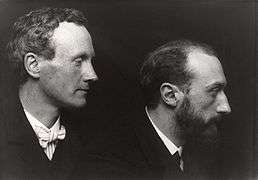Charles Haslewood Shannon
| Charles Haslewood Shannon | |
|---|---|
 Self-portrait, 1897 | |
| Born |
April 26, 1863 Lincolnshire, United Kingdom |
| Died |
March 18, 1937 Kew, United Kingdom |
| Resting place | St Botolph's Church, Quarrington[1] |
| Education | Lambeth School of Art |
Charles Haslewood Shannon RA[2] (26 April 1863 – 18 March 1937) was an English artist. He became best known for his portraits, which can be found in several major European collections, including the National Portrait Gallery in London.
Early life
Shannon was born in Sleaford, Lincolnshire, the son of the Rev. Frederick William Shannon, Rector of Quarrington (himself the son of a Royal Navy captain, Rodney Shannon and his wife Frances Nash), and Catherine Emma Manthorp, the daughter of a surgeon, Daniel Levett Manthorp (and his wife, Elizabeth Mason).[3]
Schools and training
Shannon attended the City and Guilds of London Art School (then known as South London School of Technical Art, formerly Lambeth School of Art), and was subsequently considerably influenced by his lifetime partner Charles Ricketts[4] and by the example of the great Venetians. In his early work he was addicted to a heavy low tone, which he abandoned subsequently for clearer and more transparent colour. He achieved great success with his portraits and his Giorgionesque figure compositions, which are marked by a classic sense of style, and with his etchings and lithographic designs.[5]
Career

The Dublin Municipal Gallery owns his circular composition The Bunch of Grapes and The Lady with the Green Fan (portrait of Mrs Hacon). Another of his subjects was the popular novelist Mary Frances Dowdall. His Study in Grey is at the Munich Gallery, a Portrait of Mr Staats Forbes at Bremen, and Souvenir of Van Dyck at Melbourne. One of his most remarkable pictures is The Toilet of Venus in the collection of Lord Northcliffe. Several of his portrait works are on display in the National Portrait Gallery in London.[5]
Complete sets of his lithographs and etchings have been acquired by the British Museum and the Berlin and Dresden print rooms. He was awarded a first-class gold medal at Munich in 1895 and a first-class silver medal in Paris in 1900.[5] He was a member of the International Society of Sculptors, Painters and Gravers.[6]
Later life
Shannon became disabled in 1928 after a fall while hanging a picture, and the neurological damage that resulted caused amnesia and ended his career.[7]
References
- ↑ Darracott, Joseph (October 2009). "Shannon, Charles Haslewood (1863–1937)". Oxford Dictionary of National Biography. Oxford University Press. Retrieved 4 January 2016.
- ↑ "Royal Academy of Arts Collections - Home".
- ↑ Darracott (2004)
- ↑ Ray, Gordon Norton (1992), The Illustrator and the Book in England from 1790 to 1914, Courier Dover Publications, p. 160, ISBN 0-486-26955-8 .
- 1 2 3 Shannon, Charles Haslewood, in Chisholm, Hugh, ed. (1911). Encyclopædia Britannica (11th ed.). Cambridge University Press.
- ↑ "The International Society of Sculptors, Painters and Gravers". Mapping the Practice and Profession of Sculpture in Britain and Ireland 1851-1951. Glasgow University. Retrieved 31 May 2013.
- ↑ The Sir Edmund and Lady Davis Presentation: A Gift of British Art to South Africa, South African National Gallery, 1999
![]()
- Darracott, Joseph, Shannon, Charles Haslewood (1863–1937), Oxford Dictionary of National Biography
- Derry, Georges (December 1914). "The Lithographs of Charles Hazelwood Shannon (with catalogue)". The Print Collector’s Quarterly. 4 (4): 393.
External links
- 59 paintings by or after Charles Haslewood Shannon at the Art UK site
- Portraits by Shannon (National Portrait Gallery, London)
- Portraits of Shannon (National Portrait Gallery, London)
- Guide to the Carl Woodring collection on Charles Ricketts and Charles Shannon, 1846-2001 (Woodson Research Center, Fondren Library, Rice University, Houston, TX, USA)
- Charles Shannon at Library of Congress Authorities, with 3 catalogue records